How to Fix League of Legends ‘Error Code 900’
Some League of Legends players are encountering the Error code 900 (You have encountered an error) when trying to access the game’s built-in store. This issue is reported to occur on Windows 7, Windows 8.1, and Windows 10.
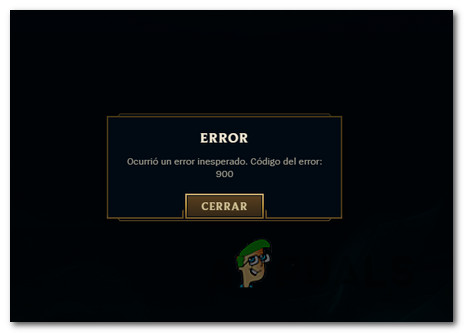
As it turns out, there are several different scenarios that are known to cause this particular error code. Here’s a shortlist of potential culprits that might be responsible for this issue:
- Widespread server issue – Before you attempt any of the fixes presented below, you should take the time to investigate whether Riot is currently dealing with severe issues that are affecting players in your area. There are a couple of different ways to check on the current status of League of Legends servers.
- Client inconsistency – As it turns out, this particular error code can also occur due to a simple game store glitch. According to most affected users, you should be able to resolve this simply by restarting the LOL game client and re-signing with your account credentials.
- Corrupted Internet Options cache – Since the LOL launcher uses Internet Explorer dependencies, there are some documented instances where some temporary files generated by the Store component might end up creating this error code. In this case, you should be able to fix this problem by clearing the Internet Options Cache.
- Corrupted League of Legends installation – Under certain circumstances, you might also see this error due to some type of corruption affecting your game files. To fix this particular issue, you’ll need to uninstall League of Legends completely and re-download the latest game version through the official channels.
- Antivirus or Firewall interference – As it turns out, this problem can also appear due to an overprotective firewall or antivirus suite. In this case, your first attempt at resolving the conflict should be to whitelist the game’s executable and all the ports that it uses. If that’s not applicable, the only thing you can do to resolve the conflict is to uninstall the problematic AV or Firewall.
- Account related issue – If you’re encountering other issues when attempting to engage in matchmaking, you might be dealing with an account issue. Depending on your in-game behavior, you might have received a temporary ban that is preventing you from accessing certain game features. In this case, you should open a support ticket with Riot Games and ask a support tech to investigate.
Method 1: Investigating a Server Issue
Before you try any of the other fixes below, you should start by checking whether Riot games is currently dealing with a widespread server issue that is affecting users in your area.
Fortunately, Riot Games has an official status page where they are fairly quick to report issues with their games – Just select a language from the list and see if there are any ongoing issues with League of Legends.
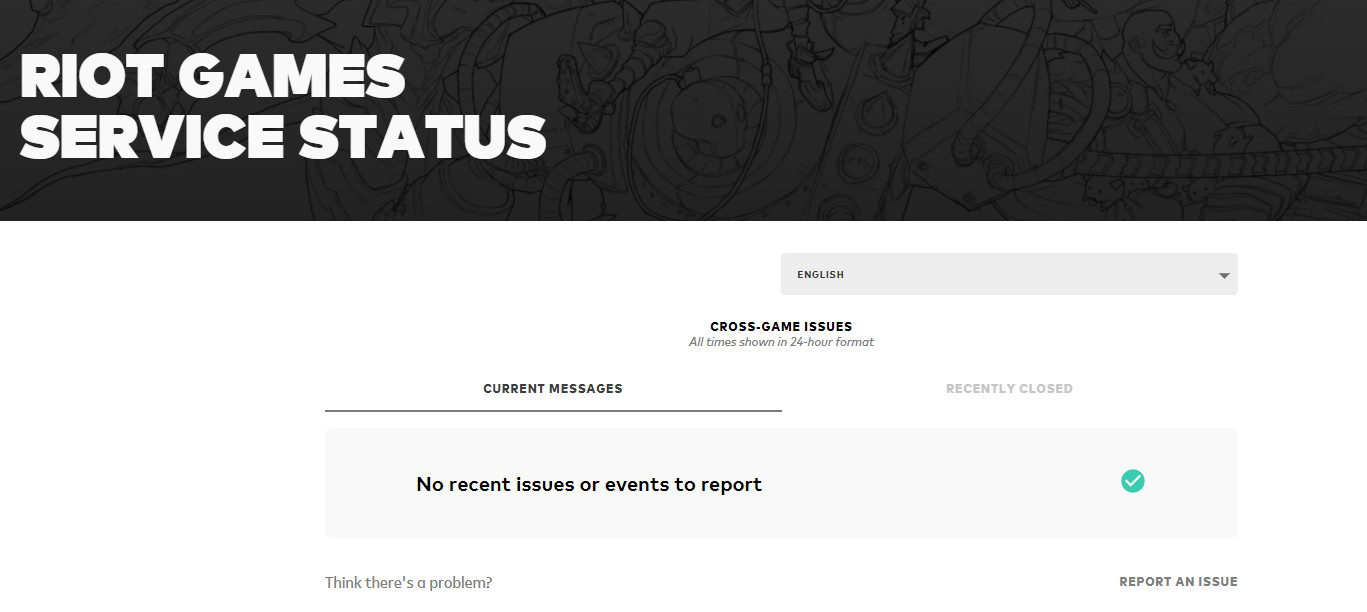
Additionally, you can check directories like DownDetector or ServiceDown and see if other users in your area are currently facing similar server issues.
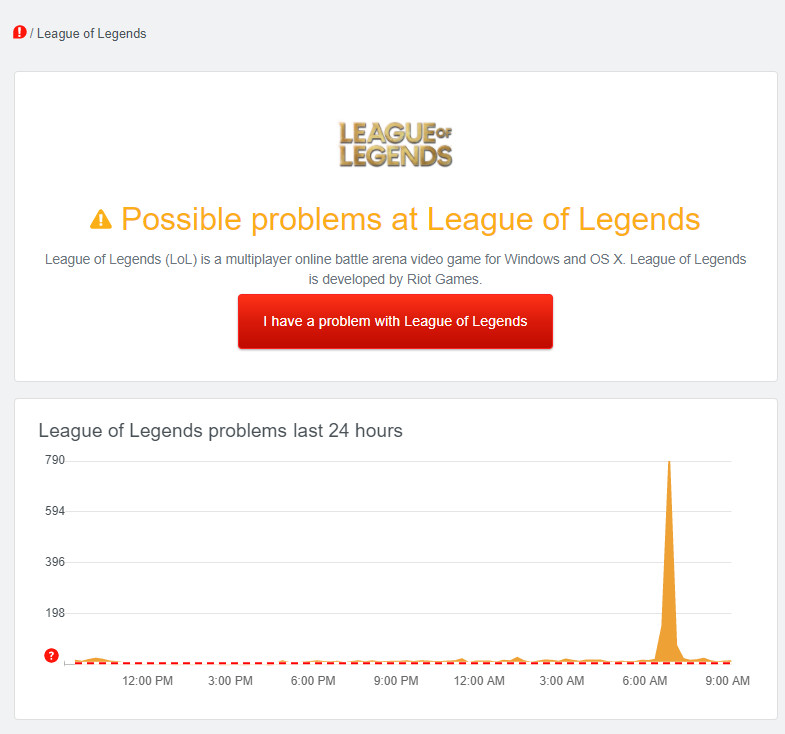
Note: If you have successfully confirmed that you’re currently dealing with a server issue, none of the fixes below will fix the issue for you. In this case, the only thing you can do is wait for the issue to be resolved by Riot developers
On the other hand, if the investigation you just did have made you realize that this is not a server problem, start troubleshooting using the other methods below.
Method 2: Restarting the Game’s Client
If you haven’t tried this yet, you should start by simply rebooting the League of Legends client. According to some affected users, this has ended up fixing the Error code 900 on a lot of Windows computers.
Additionally, you should also sign out of your account before restarting the client. To do this, click on the X icon in the top-right corner of the screen, then click on Sign Out from the newly appeared context menu.

Once you have successfully signed out of your LOL game client and you’ve closed it successfully, open it once again and reinsert your user credentials before attempting to access the store once again.
If the issue is still not fixed and you’re still seeing the same 900 error code, move down to the next potential fix below.
Method 3: Clearing Internet Options Cache
According to some affected users, this problem can also occur due to an Internet Explorer cache issue. This is quite likely because the Riot Games launcher is built on the IE infrastructure which has a history of corrupted cache issues.
If you haven’t tried this yet, you might be able to fix this problem by opening the Internet Options screen and clearing your cache. Several affected users have confirmed that this operation finally allowed them to access the League of Legends store without seeing the same 900 error code.
Here’s a quick guide on clearing the temporary internet files cache from Internet Options:
- Ensure that League of Legends and the game launcher are completely closed.
- Press Windows key + R to open up a Run dialog box. Next, type ‘inetcpl.cpl’ inside the text box, then press Enter to open up the Internet Properties screen.
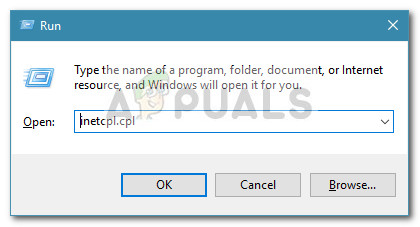
Run dialog: inetcpl.cpl - Inside the Internet Properties screen, click on General tab, then click on the Delete button under Browsing history.
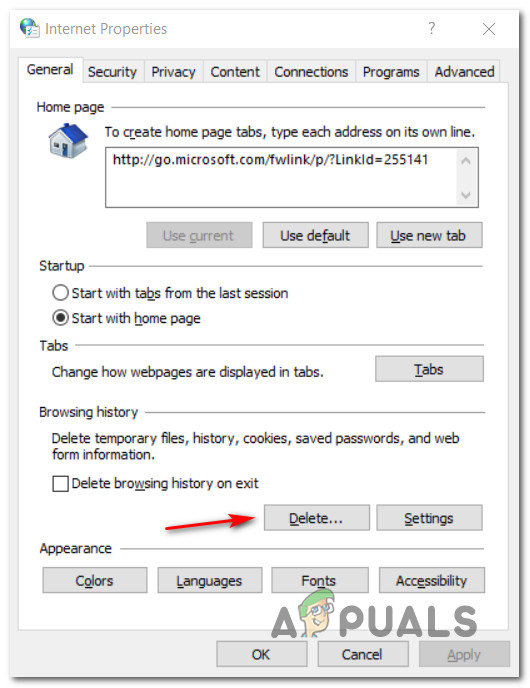
Deleting the IE browser cache - From the Delete Browsing History screen, check the following boxes and leave the other ones unchecked:
Temporary Internet Files and website files Cookies and website data Form Data
- Pme the Delete Browsing History window is correctly configured, click on Delete and wait for the operation to complete.
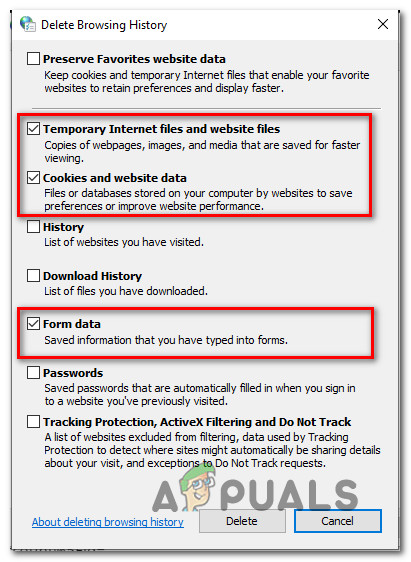
Deleting the cache folder of Internet Explorer - Once the operation is complete, launch League of Legends once again, open up the store and see if the 900 error code is still occurring.
If the same problem is still occurring, move down to the next potential fix below.
Method 4: Reinstalling League of Legends
If none of the potential fixes above have worked so far, you should start considering the fact that you might be dealing with some kind of corrupted game files. This problem is most typically reported to occur after a security scan ended up quarantining some items belonging to the game (or some game dependencies).
If you haven’t tried this so far, follow the instructions below to reinstall League of Legends conventionally and eliminate any corrupted files that might be causing the 900 error code:
- Press Windows key + R to open up a Run dialog box. Next, type ‘appwiz.cpl’ inside the text box and press Enter to open up the Programs and Files menu.

Type appwiz.cpl and Press Enter To Open Installed Programs Page - Once you’re inside the Programs and Features menu, scroll down through the list of installed applications until you locate your League of Legends installation.
- When you see it, right-click on it and choose Uninstall from the newly appeared context menu.

Uninstalling League of Legends - Inside the uninstallation screen, follow the on-screen instructions to complete the operation, then reboot your computer.
- Once the next startup is complete, download the latest client version of League of Legends from the official website and follow the instructions to complete the installation.
- After the installation is complete, open the game once again and see if the problem is now fixed.
If the problem is still not resolved, move down to the next method below.
Method 5: Whitelisting LOL executable in Firewall & Antivirus
According to some affected users, you might also expect to see this error due to the fact that your active antivirus ends up blocking the connection between the game and the game server. This problem is confirmed to occur by both users that were using the built-in AV / Firewall combo and users that were using 3rd party equivalent.
If this scenario is applicable, one of the fixes that should allow you to fix the issue is to whitelist the main League of Legends executable and whitelist all the ports that the game uses in order to prevent the conflict.
For obvious reasons, we can’t provide you with the steps on how to do this on a 3rd party Firewall / Antivirus since the steps are specific to each developer.
However, if you’re using Windows Defender with Windows Firewall, follow the instructions below to whitelist the game executable and ports in Firewall settings:
- Open up a Run dialog box by pressing Windows key + R. Next, type ‘control firewall.cpl’ inside the text box and press Enter to open up the Windows Firewall window.
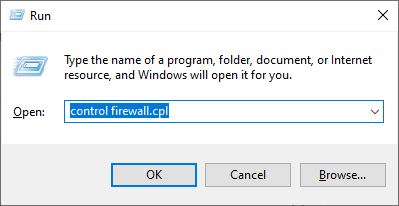
Accessing the Windows Defender Firewall - Once you’re inside the Windows Defender Firewall screen, click on Allow an app or feature through Windows Defender Firewall.

Allowing an app or feature through Windows Defender - Once you’re inside the allowed apps menu, click on Change settings button, then click Yes at the User Account Control prompt.

Changing the Settings of the Allowed Items in Windows Firewall - Once the list becomes fully editable, click on Allow another app (directly under the list), then click on Browser and navigate to the location where you installed League of Legends.

Allow another app - Once you have successfully managed to add the main game executable to the list of allowed items in the Windows Firewall, find the entry inside the Allowed apps and features list and ensure that both the Private and Public boxes are checked.
- After the correct modifications are operated, follow step 1 again to return to the initial firewall menu. Once you’re back to the initial menu, click on Advanced Settings from the menu on the left.
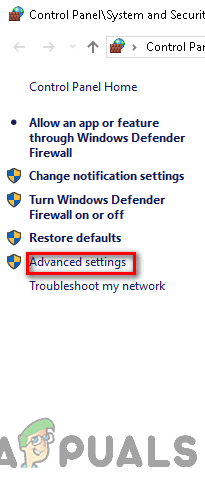
Click on the advance settings option to open firewall rules Note: When prompted by the UAC (User Account Control), click Yes to grant admin access.
- At the next screen, click on Inbound Rules from the menu on the left, then click on New Rule.
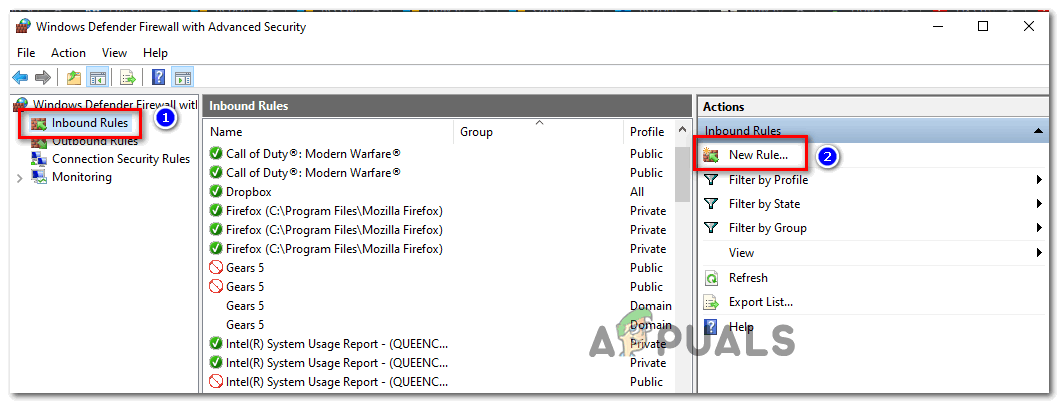
Creating New Rules in Windows Firewall - Inside the New Inbound Rule Wizard, click on Port when asked to select the Rule Type, then click on Next.
- Finally, choose TCP / UDP from the list of options and enable specific local ports, then ensure that every port featured below is added:
5000 - 5500 UDP (League of Legends Game Client) 8393 - 8400 TCP (Patcher and Maestro) 2099 TCP (PVP.Net) 5223 TCP (PVP.Net) 5222 TCP (PVP.Net) 80 TCP (HTTP Connections) 443 TCP (HTTPS Connections) 8088 UDP and TCP (Spectator Mode)
- Once you arrive at the Action prompt, click on Allow the connection and hit Next once again.
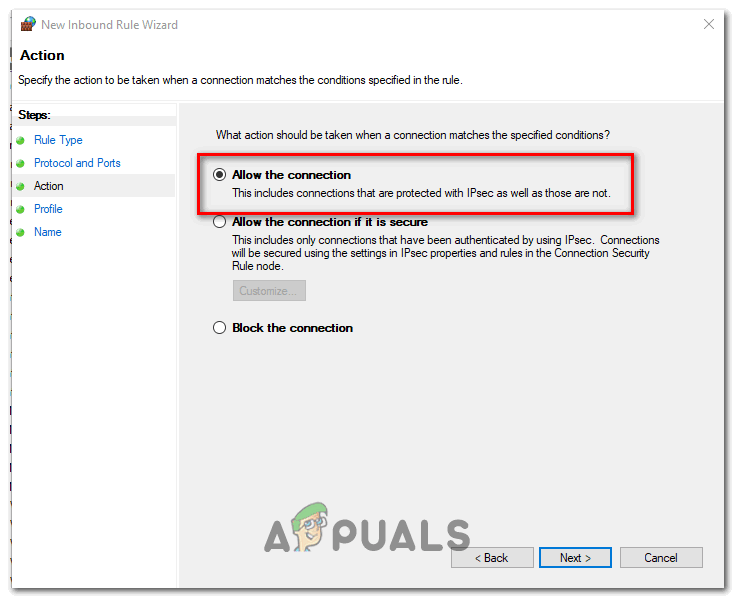
Allowing the connection - When you get to the Profile step, start by enabling the boxes associated with Domain, Private and Public before clicking on Next once again to save the changes.

Enforcing the rule on various network types - Ensure that your exception rule you’ve just created is active, then click on Finish to complete the procedure.
- Once every potential port that League of Legends might use is whitelisted, restart your computer and launch the game at the next startup to see if the problem is fixed.
If the same problem is still occurring, move down to the next potential fix below.
Method 6: Uninstalling 3rd party AV Suite (if applicable)
If you’re using a 3rd party suite that you suspect might be conflicting with the game and you were unable to whitelist the game (and it’s used ports), the only thing you can do at this point is to uninstall it temporarily and see if the 900 error code stops occurring.
Keep in mind that with some AV suites, disabling real-time protection will not be enough since the same security suites will still be enforced. But if you want to try disabling the real-time protection, you can typically do it directly via the tray bar icon of the antivirus.

If this doesn’t work, follow the instructions below to uninstall your current 3rd party antivirus or firewall solution:
- Press Windows key + R to open up a Run dialog box. Inside the text box, press ‘appwiz.cpl‘ and press Enter to open up the Programs and Files menu.

Type appwiz.cpl and Press Enter To Open Installed Programs Page - Inside the Programs and Features menu, scroll down through the list of installed programs and locate the 3rd party antivirus that you suspect might be causing the conflict. When you see it, right-click on it and choose Uninstall from the newly appeared context menu.
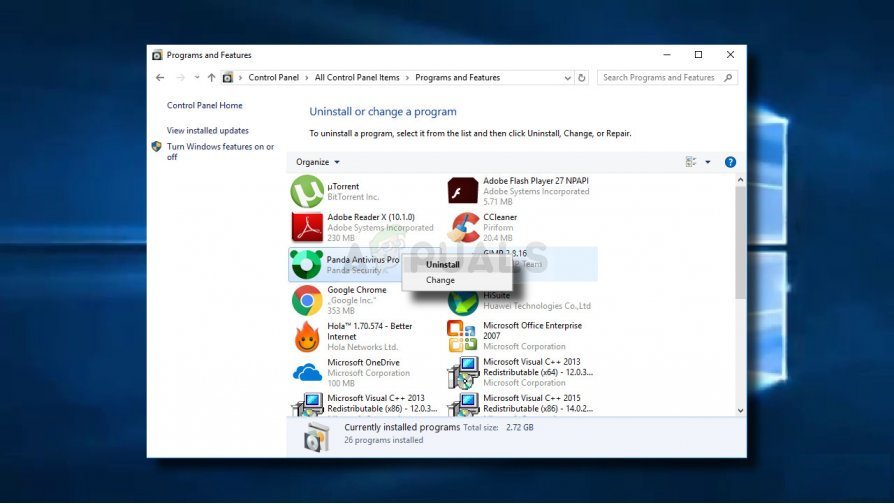
Uninstalling antivirus tool - Inside the uninstallation screen, follow the on-screen instructions to complete the uninstallation, then restart your computer at the end of it.
- Once your computer boots back up, launch League of Legends once again and see if the problem is now resolved.
In case you’re still seeing the same 900 error code when trying to access the Store inside League of Legends, move down to the final fix below.
Method 7: Opening a Support Ticket with RiotGames
If none of the methods above have worked for you, you should try opening a ticket with the League of Legends developer. In case the problem is ongoing, the only thing you can do by now is to open a support ticket and wait for a resolution for tech support.
Fortunately, Riots tech support agents are notoriously known for being very good and quick. If you want to open a support ticket, follow the instructions below to do so:
- Open your favorite browser and access the Riot games support link.
- Inside the support link, click on League of Legends from the list of available options.

Opening a support ticket with League of Legends - From the next menu, click on Get Tech Help from the list of options.

Getting Tech Help from Riot Support - From the next screen, scroll down to the bottom of the screen and click on Submit Ticket (under ‘Can’t Find what you’re looking for‘)

Submitting a ticket on Riot Games support - Finally, choose a Request type from the list of available options, then hit submit and wait for a support agent to get back at you.





